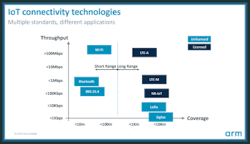With the Internet of Things (IoT) converging into our market over the past several years, we have heard a lot of discussion in the lighting industry about IoT connectivity technologies. There are many options for hardware, software, and network configuration, and we have noted that opinions sway in various directions as to what is the best course for smart lighting systems. Despite the fact that some industry insiders insist that Bluetooth Mesh will become a mainstay for smart building systems, the question remains: Will there be one protocol to rule them all? (My sincere apologies to the legacy of J.R.R. Tolkien and the excellent director Peter Jackson for my appropriation of the Lord of the Rings film series’ infamous tagline.)
According to Arm’s head of IoT solutions Aniruddha (Ani) Deodhar, who has presented not one but two webcasts on smart-lighting system architecture and security with us, the answer is not simply yes or no. During the Nov. 13 webcast Q&A, moderator and chief editor Maury Wright asked him to expand on the showdown of connectivity types based on some attendee questions.
Maury Wright: I know this wasn’t really necessarily the focus of your presentation today, but we do have one of our attendees who says, “Why use Bluetooth Low Energy [BLE] instead of Wi-Fi?” And really the larger question is how do you make decisions on networking protocol in general? And I don’t know if there are any security angles to that question or not. The attendee did not say anything about security.
Ani Deodhar: That’s a good question. Essentially, some of the protocol choices are really dictated by the throughput and coverage requirements. But oftentimes, the protocol choices are also dictated by just some of what I call the “nonstructural elements” — the big one being the resident IT department and the facility management department. Oftentimes, companies sidestep the IT department by having their own proprietary 802.15.4 kind of network outside of the Wi-Fi network. BLE allows you to do that as well as allows you to pair with your phones. A lot of devices now have that pairing function, so it has become really easy to be interoperable with other devices. And some things like range and security are now taken care of in the BLE 5.0; with BLE Mesh, issues like range hopping are resolved, so the technology is now capable of delivering range similar to Wi-Fi for huge, multi-thousand-square-foot facilities as well.
I don’t know if there’s a best answer to this question, really; things are still evolving. Every couple of years, you see new protocols emerging, but we see a lot of queries around BLE Mesh and Thread nowadays, as well as LoRa [a long-range digital wireless communication technology]. So I don’t really have one answer for that; it really depends on the BOM [bill of materials] cost, the radio range requirements or throughput capability, as well as some of the nonstructural issues I mentioned around the IT constraints.
MW: Kind of reading between the lines, if you would allow me to do so, when I was listening to your presentation and you talked about abstracting APIs [application programming interfaces] to cross really any choice of network connectivity… So what my thinking was when I heard that part of the presentation was you, clearly, or Arm doesn’t see a simple path forward where one thing’s going to take over and be the ubiquitous choice. And therefore, a way to abstract to any of that kind of connectivity is probably going to be key for companies playing in the smart lighting space.
AD: Absolutely, because […] regardless of the choice you make, you might have a standard set of offerings with that choice that you made, based on the best possible wisdom in the company, and internal knowledge based on what the right protocol is from a security, range, coverage standpoint. But when you actually go into the field, the customers may have different constraints and requirements based on the real-life situation; and so even if you might start with one of these protocols, you might end up with this and some other protocols to grapple with — and that connectivity abstraction becomes very, very critical.
You can register and view this webcast on demand to get the full presented materials and downloadable resources on building secure smart lighting systems.
Get to know our expert
A few examples of how communications protocols and network architectures can fit into the scheme of smart lighting and buildings
Bluetooth Mesh — What's that noise about?
Choose open, interoperable lighting controls for commercial project success
Why IP to the end node in SSL is the end game
Understand BACnet communications for control and monitoring of networked lighting







